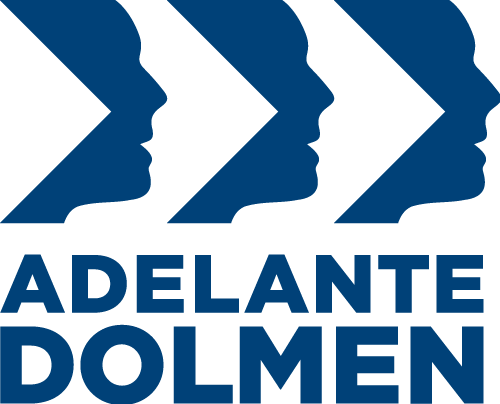Andrea Serpi is HR & Disability Manager at Adelante Dolmen.
What is Adelante Dolmen?

Adelante Dolmen is a company in the form of a social cooperative, i.e. one that, according to the constitutive law n.381 of 1991, has no profit motive, but a social mission. Adelante Dolmen produces services for the market and promotes employment and inclusion for disadvantaged population groups. The law indicates them in a precise way: recognised conditions of disability, detention, drug addiction and so on. Adelante Dolmen produces services in the IT sector, in the field of business services, so office and clerical activities. We have commercial contracts with companies and we also participate in public administration tenders. As I said, it is a social cooperative, 25 years old, founded in 1997. Today it has eighty worker members, 50 of whom are people with disabilities. In fact, according to the law, social cooperatives must have at least 30% of their employees belonging to one of those categories of social disadvantage. The aim is therefore to offer an opportunity for social promotion and equal opportunities to sections of the population that otherwise risk being excluded from the world of work and therefore from a certain citizenship status.

So you deal mainly with disability and work – what is the situation in Italy?
First of all I would like to point out the indicative data on the employment rate: the absolute employment rate in Italy is almost 58%, lower than the European one which is 68%; but even lower is the one concerning workers with disabilities, in Europe it is 50%, while in Italy it is only 31%. There is still a lot to do to increase the employment rate of workers with disabilities, but this is a problem of the whole labour market. This should be a starting point for labour policies in Italy and in particular for those related to disabilities and to the so-called compulsory employment (now called targeted employment) that facilitates the employment of persons with disabilities.
The issue of disability from my point of view is a cultural issue, linked to a vision of the forms of what used to be called handicaps. It is an issue that arose historically with the great wars of the 20th century that created a mass of people with limitations and pathologies. Obviously these have always existed in history, but the issue gained great social importance with the great wars.
Today there is still a lot to be done at a cultural level because the theme of disability carries with it very stereotyped visions. In the last few years I think that social and cultural sensitivity has changed with regard to how disability is seen. I see this phenomenon as a step forward, a success at cultural level. I think this is very evident in two areas: in the world of sport, with the Paralympics that have achieved a visibility that they did not have before and therefore have brought dignity to Paralympic sport, which is now talked about; the other channel is that of social media and communication because people with disabilities have begun to talk publicly about their lives and their daily lives, the fact that they live with more or less severe conditions.
Traditionally, disability has always been talked about according to two extreme polarities: fake invalids or superheroes. In between, however, there is a normality of living with a difficult condition, which can lead to complications in everyday life. In recent years, however, I have noticed a normalisation of the discourse and way of talking about disability. Many people on social networks talk about everyday life, about living with a disability, and this lowers stigmas, prejudices and stereotypes. This reduces stigmas, prejudices and stereotypes. In short, it allows a greater knowledge of disability as a health and life condition.
In your opinion, is storytelling a tool for social justice?
We at Adelante Dolmen got to know it through ISTUD and the research it did in 2019 on Disability and Work. The topic of social justice which is a huge topic; I can say that narrative as an approach brings the person and their life experience back to the centre and makes the person’s experience take on value. Narrative allows us to have the person’s point of view on the issue of disability and to fight stereotypes and prejudices; it increases the knowledge of the condition of a phenomenon and in this sense it increases the social maturity on the issue and actually leads to results of greater equity in dealing with discrimination. Situations that previously existed but were not addressed are now addressed precisely because they are recognised as discriminatory. So in effect, yes, the outcome is one of greater social justice.
What was Adelante Dolmen’s view of the Disability and Work project? Were there any surprises?
There were no surprises. It was interesting to learn about the narrative medicine approach because of the points of contact we found with the perspectives on disability. There can be different perspectives on the subject, social or educational or more strictly medical. Our point of view, mainly related to work as a lever to create equal opportunities and social integration, is of the first type. As social workers, almost all of us have a pedagogical background, which is not strictly medical or health-related, so our view of disability is social and educational. Narrative medicine brings forward an idea of health that is close to this, which takes into account the cultural dimension, not only the strictly medical-biological data. We look at disability as a health condition, but also as part of a social context.
For some twenty years now, the model of disability approved by the World Health Organisation has been the bio-psycho-social model, which forms the basis of the International Classification of Disability Functioning. This classification takes into account the overall sense of a person’s experience of life. Disability is no longer defined by impairments as it was in the past, but is defined as a health condition in interaction with the context. This seems paradoxical, but to give an immediate example, a person in a wheelchair with an optimal level of health who lives independently and works is a person for whom the definition of disability almost disappears. It is a person who can access all the opportunities offered. So there is a condition of health and well-being within a bio-psycho-social interaction, therefore overall.
The idea of placing disability alongside a health condition says that health can change over the course of a lifetime, so it is a condition that can affect anyone, it is not a given of birth, marked by a starting point, but it is a condition that has a variability, that can change over the course of a lifetime or with more or less favourable conditions, in fact the ICF, the classification of functioning, works and reasons on barriers and on elements of advantage, in favour.
Narrative therefore becomes an instrument of social justice because it is the one that allows us to understand where the knots of the problems presented are and to explore this always relative and relational relationship between the environment and the person, between health and the context. Awareness then solutions.
For example, storytelling can reveal that the condition of risk of exclusion or suffering or isolation of a person with disabilities is not due to the specific pathology of which that person is a carrier, but may be due to social conditions, life, the labour market, the barriers that the person encounters. So, narration allows to reveal this and in this sense it does a work of social justice because it also indicates where to act. From our point of view, working on the labour market, when we meet companies, we often find barriers and stereotypes, lack of knowledge or prejudices and when we lower these barriers or change the perception, then we create the conditions for labour integration. The person with a disability has the possibility to get out of his or her pathology – I am thinking of physical conditions of motor skills or sensory limitations.
